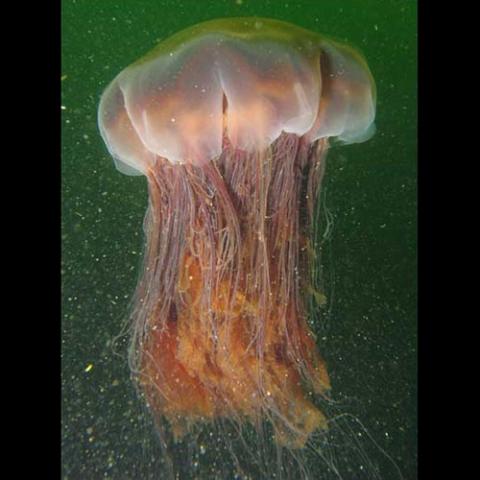NAMES
TAXONOMY
Hong Kong
Issued:
Stamp:
Cyanea capillata
Hong Kong
Issued:
Stamp:
Cyanea capillata
Hong Kong
Issued:
Stamp:
Cyanea capillata
Genus species (Animalia): Cyanea capillata
The lion's mane jellyfish (Cyanea capillata), also known as the giant jellyfish, arctic red jellyfish, or the hair jelly, is one of the largest known species of jellyfish. Its range is confined to cold, boreal waters of the Arctic, northern Atlantic, and northern Pacific Oceans. It is common in the English Channel, Irish Sea, North Sea, and in western Scandinavian waters south to Kattegat and Øresund. It may also drift into the southwestern part of the Baltic Sea (where it cannot breed due to the low salinity). Similar jellyfish – which may be the same species – are known to inhabit seas near Australia and New Zealand. The largest recorded specimen was measured by Alexander Agassiz off the coast of Massachusetts in 1865 and had a bell with a diameter of 210 centimeters (7 feet) and tentacles around 36.6 m (120 ft) long. Lion's mane jellyfish have been observed below 42°N latitude for some time in the larger bays of the east coast of the United States.
The lion's mane jellyfish uses its stinging tentacles to capture, pull in, and eat prey such as fish, zooplankton, sea creatures, and smaller jellyfish.
Description
Lion's mane jellyfish (Cyanea capillata) are named for their showy, trailing tentacles reminiscent of a lion's mane. They can vary greatly in size: although capable of attaining a bell diameter of over 2 m (6 ft 7 in), those found in lower latitudes are much smaller than their far northern counterparts, with a bell about 50 cm (20 in) in diameter. Juveniles are lighter orange or tan, very young lion's manes are occasionally colorless and adults are red and darken as they age.
While most jellyfish such as Moon Jellyfish have a circular bell, the bell of the Lion's Mane is divided into eight lobes that resembles an eight-pointed star, each lobe contains about 70 to 150 tentacles, arranged in four fairly distinct rows. Along the bell margin is a balance organ at each of the eight indentations between the lobes – the rhopalium – which helps the jellyfish orient itself. From the central mouth extend broad frilly oral arms with many stinging cells. Closer to its mouth, its total number of tentacles is around 1,200.
The long, thin tentacles which emanate from the bell's subumbrella have been characterized as “extremely sticky”; they also have stinging cells. The tentacles of larger specimens may trail as long as 30 m (100 ft) or more, with the tentacles of the longest known specimen measured at 36.6 m (120 ft) in length, although it has been suggested that this specimen may actually have belonged to a different Cyanea species. This unusual length – longer than a blue whale – has earned it the status of one of the longest known animals in the world.
Reference: Wikipedia


